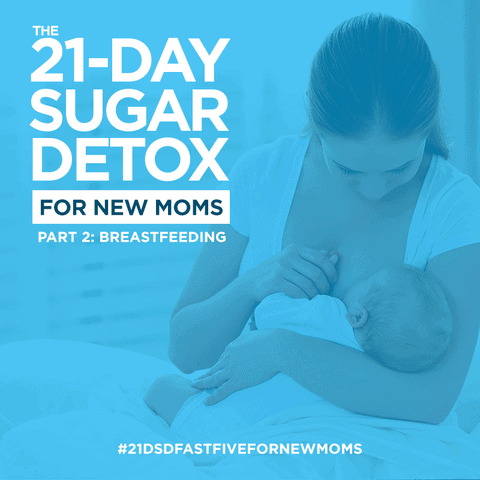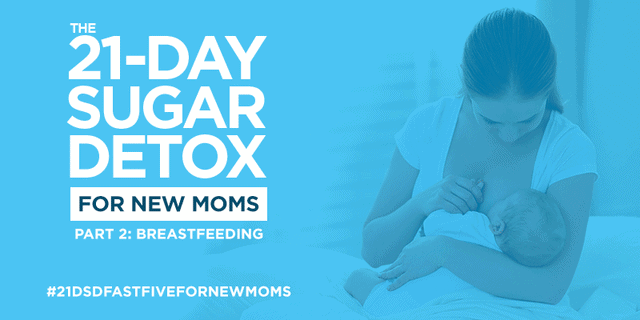Congratulations! You now have a wonderful little baby who will grow and change before you can blink! If you are breastfeeding, you will want to continue the good eating habits you developed during pregnancy, and you may be ready to cut out the sweets and really focus on getting the best nutrition for your recovering body and for your growing little one.
Are you ready to take the plunge and do a 21DSD? Check out our top five tips and tricks for breastfeeding women.
#1. Is it safe to do a “detox” while breastfeeding?
The 21DSD isn’t a traditional “detox” in which your body sheds toxins which can then transfer to your breastmilk. The purpose of the 21DSD is to regulate your blood sugar, reduce your sugar cravings, and help you create new habits…and it is perfectly safe while breastfeeding. You will be eating real, whole foods that will nourish you and your breastfeeding babe. Many, many new moms have successfully completed a 21DSD while still breastfeeding their babies, and you can, too!
That said, it is advised that you do not begin any kind of eating plan or program that may result in weight loss until after two months postpartum. You should be eating as much as you want/need to so your body can recover from childbirth and so that you and your baby can get used to your new breastfeeding relationship. If you find that you are beginning to lose weight while on the 21DSD, reevaluate how you feel, your milk supply, and the health of your baby before continuing. Your health and the health of your baby are most important.
One more note: the 21DSD takes a significant amount of preparation, both mentally and in terms of shopping for and preparing food. If you are beginning a 21DSD while breastfeeding, make sure that you are able to adequately prepare or that you have someone (partner, spouse, family member, best friend) who can help you be successful.
#2. You’re in? Take it easy!
You are likely very tired, especially in the early months, and you may experience problems with breastfeeding, especially if this is your first baby. If you are having trouble with latch or positioning, consult a lactation consultant or a member of the La Leche League for support and advice. Make sure you get enough rest (the housework really can wait), and enlist the help of family and friends. You may feel that you “should” be able to handle all of the caregiving, cooking, and cleaning tasks (in addition to work duties if you are employed outside the home), but you might still need extra help for as long as you are breastfeeding…and this is okay.
Getting quality rest and nourishment is what your baby and your body need to recover from childbirth and continue in optimal health.
#3. Add some starchy vegetables to each meal.

You will be most successful doing the 21DSD while breastfeeding when you add sufficient activity carbs (starchy, dense carbohydrates) to support your body’s increased need for dense carbohydrates and energy. Your body is working hard to make milk and recover from childbirth—make sure you give it what it needs!
Adding plenty of dense carbohydrates to your meals will keep you well-nourished and help you produce high-quality milk for your newborn. Sweet potatoes, potatoes, pumpkin, acorn or butternut squash, plantains, etc. are starchy vegetables. Add ½ – 1 cup of these dense carbohydrates to each meal; the goal is to add 30–50g starchy carbs to each meal for a total of 90-150g per day. We also recommend that you eat either one green-tipped banana or one green apple each day as well. This will provide some extra carbohydrates and add to the variety of foods you can choose from.
If you are breastfeeding, you need the increased carbohydrates in order to fuel milk production and to give you energy through the day. Your body is working hard and you need to continually replenish the nutrients you have used up in daily activities.
As a busy new mother, be sure to also consider the role that fatigue and sleep play in increasing sugar cravings, disregulating blood sugar and reducing satiety. These factors are another reason that it is vital to be prepared with some quick and easy meal and snack options from the YES foods list (Check out the “Building Your 21DSD Plate” guide on page 22 in The 21 Day-Sugar Detox Daily Guide for quick and easy YES food combinations for when you’re in a rush).
While the 21DSD is not a low- carb eating program, it can become one if you don’t include enough vegetables in your meals. While breastfeeding moms need adequate protein and fat, they also need the nutrients, fiber, and carbohydrates from vegetables (and fruit). People who eat low–carb diets tend to self–restrict calories because they feel satisfied. However, this can cause problems for breastfeeding women who need a certain level of calories in order to maintain adequate weight and provide sufficient nutrients for both mom and baby’s needs. While you may not feel as hungry following a 21DSD eating plan, you still need up to 2,700 calories per day or even more (depending on your height, weight, activity level, and nutritional status). While we don’t advocate counting calories for restrictive reasons, it is especially important for breastfeeding women to consume enough calories on a regular basis to support your needs.
#4. Drink plenty of water.
Keeping hydrated is essential for optimal health and for maintaining a good milk supply. It can also be challenging for new moms who are sleep-deprived and busy with childcare duties. You will want to make sure you are drinking enough fluids, especially water and bone broth, and you can do this by filling up several water bottles or cups and stationing them around your house. Choose places that are easy to access, such as a table near where you typically breastfeed your child or your nightstand. Take sips of water throughout the day to ward off dehydration.
#5. Making milk is hard work—tips for keeping it flowing.
Some women find that their milk decreases when they eliminate grains and legumes and cut back on fruit or other sugary foods. It is important to get enough carbohydrates to support milk production, but if you suspect that you have a lessening supply, try these tips (in this order):
Make sure you are eating enough—you might want to lose that baby weight, but this is not the time to focus on weight loss. A sudden and/or rapid decrease in calories can trigger your body to conserve energy and therefore lead to lower milk production. Also, you might not feel hungry while on the 21DSD if you are eating more protein and fat than you usually do, but you need to make sure you are consuming sufficient calories to support your body’s activities plus milk production. You need 300–500 extra calories a day to keep up your milk supply, so it is vital that you eat enough.
You might also consider this 21DSD-friendly lactation cookie—it is a great snack (and freezes well) even if you aren’t struggling with low supply.
Add even more dense carbs (one more 1⁄2–1 cup serving per day to start and increase if necessary). This is in addition to the modifications above! So if you are already adding in 1⁄2 cup of sweet potato per meal, add in another 1⁄2 cup for a total of 2 cups per day. Make adjustments as needed based on how you feel and how your baby is feeding.
Increase your nursing frequency. Babies go through growth spurts during which they demand more milk, and dietary changes can also influence milk supply. If you find that your baby is hungrier or less satisfied after a feeding, try breastfeeding more frequently or for longer periods of time until your body adjusts to the dietary changes you are making. You can also pump between feedings to try and increase your supply.
Supplement with fenugreek, either with pills or tea. If you think you might want to supplement, consult your doctor or midwife and read this article before you begin taking any. This should be your last resort after you have tried all of the above suggestions.
Are you a breastfeeding woman going through the 21-Day Sugar Detox right now? We wish you success in creating healthy habits, eliminating sugar and carb cravings, and improving your nutrition for your benefit and for the future health of your child.
If you have more questions about how to make your 21DSD successful, we’re here to help! Drop us a question in the comments below. We’d love to hear from you!
Sources:
- La Leche League: FAQ: Is a low carbohydrate diet safe for a breastfeeding mother?
- Weston A. Price Foundation: Successful Breastfeeding and Successful Alternatives
- Kellymom: Low carb diets and breastfeeding
- Kellymom: Fenugreek Seed for Increasing Milk Supply
- Kellymom: How does a mother’s diet affect her milk?
- Kellymom: Do breastfeeding mothers need extra calories?
 Rebekah Reddy is mom to her three children (two girls, one boy), content development support member of Team Diane, and a part-time high school English/ESL teacher. She holds a BA in English with a minor in Spanish, an MA in English with an emphasis in Teaching English to Speakers of Other Languages (TESOL), and a California teaching credential. She is also a certified Nutrition Educator, 21DSD Certified Coach, and the author of the blog Half Indian Cook through which she shares recipes and writes about food and culture in her mixed-ethnicity family. Rebekah’s passion for delicious, nutritious food has led her entire family to improved health and happiness!
Rebekah Reddy is mom to her three children (two girls, one boy), content development support member of Team Diane, and a part-time high school English/ESL teacher. She holds a BA in English with a minor in Spanish, an MA in English with an emphasis in Teaching English to Speakers of Other Languages (TESOL), and a California teaching credential. She is also a certified Nutrition Educator, 21DSD Certified Coach, and the author of the blog Half Indian Cook through which she shares recipes and writes about food and culture in her mixed-ethnicity family. Rebekah’s passion for delicious, nutritious food has led her entire family to improved health and happiness!


Comments 1
Thank you!!1